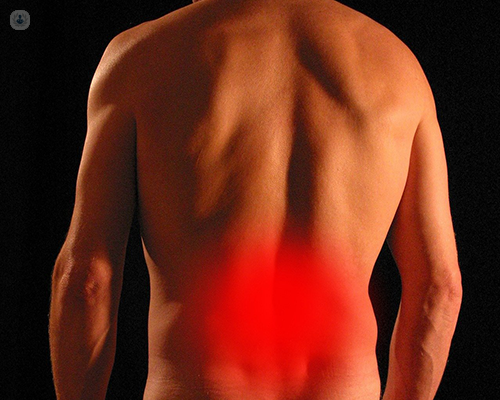Sports injuries and lower back pain
Autore:Back pain is something we’ll all prone to experiencing, particularly if we’re avid sports players or athletes. Learn from Dr John Tanner (a musculoskeletal, sports and exercise physician) about the importance of seeking a diagnosis and professional guidance for lower back pain.

Which sports can cause lower back pain and how might this occur?
Almost all sports can cause lower back pain , but the highest incidence is in gymnastics, football, diving, weight lifting, rowing and golf.
The mechanisms vary according to the characteristics of the sport e.g.
- American football linesmen will incur impact strains
- Golfers incur repetitive rotational strains
- Diving and gymnastics incur overload at the end range of motion
Ultimately, repeated or severe overload and shear stress and compression lead to failure of component parts of spinal anatomy, which are prone to degeneration with ageing anyway.
Is it common for young athletes to develop lower back pain?
Unfortunately, it is very common for young athletes to develop lower back pain . In the growing adolescent spine, not all of the vertebral growth plates have fully fused. Often, there is a mismatch between bone growth and muscle growth leading to imbalances in strength, flexibility and support.
Furthermore, training regimes have traditionally tended to underemphasise posture and core stability. And finally, in today’s highly competitive world, too intensive regimes of training can lead to tissue overload and failure.
How does a specialist evaluate lower back pain?
We start with taking the history i.e.
- The symptoms
- The development of symptoms
- The provocative and relieving factors
- Family history of genetic conditions
- A general medical history (including previous injuries to the back)
We then proceed to a detailed clinical examination to look at posture, movement of the regions of the spine and segmental motion, range, strength, flexibility and nerve function. We also locate tender tissues and segments.
The specialist may then proceed to arrange treatment based on a working diagnosis or feel the need to arrange imaging investigations or occasionally blood tests.
What are the possible complications of lower back pain (especially if people don’t seek help)?
Mostly, nothing serious happens medically when lower back pain is ignored, but prolonged pain and disability preventing a person’s return to work, play or sport, take an emotional toll. These can lead to depression, anxiety, fear of future deterioration, lack of any clear diagnosis and a lack of understanding from family, an employer, coach or manager all play into this, and can lead to prolonged and profound disability.
Back pain is the leading cause of years lived with a disability - more than cardiac conditions, respiratory issues, cancer and all other causes of disability in the West. It cannot and should not be ignored.
What should athletes do if they want to 'train through' lower back pain?
Above all, get professional advice first.
Do you have concerns about your back? Specialists such as Dr John Tanner can help – click here to learn how he can support you.


